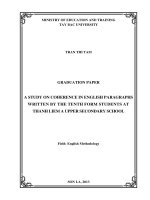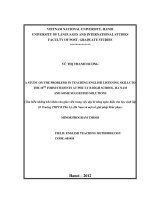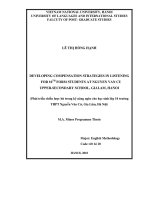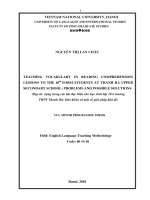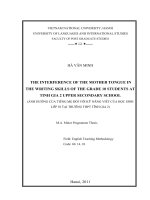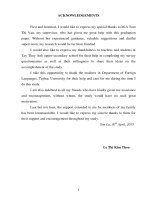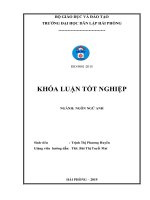GRADUATION PAPER A STUDY ON COHERENCE IN ENGLISH PARAGRAPHS WRITTEN BY THE TENTH FORM STUDENTS AT THANH LIEM A UPPER SECONDARY SCHOOL
Bạn đang xem bản rút gọn của tài liệu. Xem và tải ngay bản đầy đủ của tài liệu tại đây (951.52 KB, 62 trang )
MINISTRY OF EDUCATION AND TRAINING
TAY BAC UNIVERSITY
TRAN THI TAM
GRADUATION PAPER
A STUDY ON COHERENCE IN ENGLISH PARAGRAPHS
WRITTEN BY THE TENTH FORM STUDENTS AT
THANH LIEM A UPPER SECONDARY SCHOOL
Field: English Methodology
SON LA, 2013
MINISTRY OF EDUCATION AND TRAINING
TAY BAC UNIVERSITY
TRAN THI TAM
GRADUATION PAPER
A STUDY ON COHERENCE IN ENGLISH PARAGRAPHS
WRITTEN BY THE TENTH FORM STUDENTS AT
THANH LIEM A UPPER SECONDARY SCHOOL
Field: English Methodology
Supervisor: Mrs. Tran Thi Hong Le, MA
SON LA, 2013
ACKNOWLEDGEMENTS
First and foremost, I would like to express my sincere gratitude to my
supervisor, Mrs. Tran Thi Hong Le, MA for her valuable guidance, correction,
helpful suggestions and encouragements from the preparation to the completion
of this study.
I also would like to express my thankfulness to the teachers and the tenth
form students at Thanh Liem A upper secondary school for their help in
completing my survey questionnaires as well as sharing their ideas about some
aspects of my research.
My gratitude also sends to the teacher in the Department of Foreign
Language for their help and care for me during the time I do this study.
I am also indebted to all my friends who gave me assistance, and
encouragement, without whom, the study would have no such great motivation.
Last but not least, the support of members in my family extended to me
has been immeasurable. I would like to send my gratefulness to them for their
support and encourage throughout my study.
Son La, 10
th
May, 2013
Tran Thi Tam
K50 English Course
ABSTRACT
This study is an investigation into coherence in English paragraphs written
by the tenth form students at Thanh Liem A upper secondary school. It is
conducted to find out the coherence achievement in English paragraphs written
by the tenth form students, to investigate students' perceptions of coherence in
English paragraphs, to identify factors affecting coherence in students' English
paragraphs and to give some suggestions to improve coherence in students’
English paragraphs.
According to the data from the 120 students’ writing assignments
collected; from the survey questionnaires conducting 120 tenth form students of
3 different classes, the result reveals that the tenth form students at Thanh Liem
A upper secondary school face some difficulties, not only in the way of
expressing ideas in their English paragraphs but also in using cohesive devices,
synonyms of key nouns and consistent pronouns to make their written products
coherent. Besides, lacking the knowledge about a good English paragraph, the
students’ habits when writing paragraphs and the i
nf
l
u
e
n
ce
of
the mother tongue
are also factors affecting coherence in students’ English paragraphs although
students’ perceptions of the importance of coherence in English paragraph writing are
rather good.
From a detail discussion of the major findings, the study gives some
suggestions for teacher and students to improve coherence in students’
English paragraphs.
TABLES OF CONTENT
ACKNOWLEDGEMENTS
ABSTRACT
TABLES OF CONTENT
CHAPTER 1: INTRODUCTION 1
1.1. Rationale 1
1.2. Purposes of the study 2
1.3. Scope of the study 2
1.4. Research questions of the study 3
1.5. Methodology 3
1.6. Design of the study 3
CHAPTER 2: THE LITERATURE REVIEW 4
2.1. Theoretical background of writing 4
2.1.1. Definition of writing 4
2.1.2. The importance of writing 5
2.1.3. Kinds of writing 7
2.2. Theoretical background of paragraph 8
2.2.1. Definition of paragraph 8
2.2.2. Structure of an English paragraph 8
2.2.3. Elements of a standard English paragraph 9
2.3. Theoretical background of coherence 11
2.3.1. Definition of coherence 11
2.3.2. Cohesion versus coherence 12
2.3.3. The roles of coherence 12
2.3.4. Ways to achieve coherence 13
2.5. Summary 16
CHAPTER 3: DATA COLLECTION AND ANALYSIS 17
3.1. Situation 17
3.1.1. Aim 17
3.1.2. Participants 17
3.1.3. Textbook 17
3.2. Data collection 18
3.2.1. Students’ writing assignments 18
3.2.2. The survey questionnaires 19
3.3. Data collection 19
3.3.1. Students’ writing assignments 19
3.3.1.1. Repetition of key nouns 19
3.3.1.2. Consistent pronouns 20
3.3.1.3. Transition signals 21
3.3.1.4. Logical order 24
3.3.2. The survey questionnaires……… ……………………… … ……….24
3.3.2.1. Students’ background information 25
3.3.2.2. Students’ perception towards coherence in English paragraphs writing 26
3.3.2.3. Some common factors affecting coherence on students’ English paragraphs
29
3.4. Summary 31
CHAPTER 4: MAJOR FINDINGS AND SUGGESTIONS 32
4.1. Major findings 32
4.1.1. Findings from analyzing students’ writing assignments 32
4.1.2. Findings from analyzing the survey questionnaire 34
4.1.2.1. Students’ difficulties in the process of writing English paragraphs 34
4.1.2.2. Students' perceptions towards coherence in English paragraphs writing
34
4.1.2.3. Some factors affecting coherence in students’ English paragraphs 35
4.2. Suggestions to improve coherence in students’ English paragraphs 36
4.2.1. Some suggestions for teachers 36
4.2.2. Suggestions for students 38
4.3. Summary 41
CHAPTER 5: CONCLUSION 42
5.1. Summary and emphasis 42
5.2. Limitations and suggestions for further study 42
REFERENCES
APPENDICES
LIST OF TABLES AND CHARTS
Table 1: Use of key nouns 19
Table 2: Use of consistent pronouns
20
Table 3: Use of transition signals
21
Table 4: Use of logical order 24
Table 5: Students’ background information 25
Figure 1.1. Students’ perceptions of the importance of coherence in English
paragraphs writing 26
Figure 1.2. Students’ frequency in paying attention to coherence when writing
English paragraphs 27
Figure 1.3 Students’ explanation to the importance of coherence in English
paragraph writing 27
Figure 1.4. Students’ ways to achieve coherence 28
Figure 1.5. Students’ experience in writing English paragraphs 29
Figure 1.6. Students’ habits when writing English paragraphs 29
Figure 1.7. Students’ ways of writing English paragraphs 30
Figure 1.8. Students’ prior criteria in English paragraphs writing 31
1
CHAPTER 1
INTRODUCTION
1.1. Rationale
In the world today, there are 5,000 to 6,000 living languages among
which English is by far the most widely used. As a mother tongue, it ranks
second only to Chinese, which is little used outside China. English is spoken by
more people than any other language, and is the native language of more than
350 million people. And it is also the international language of diplomacy,
business, science, technology, banking, computing, medicine, aviation, UN &
NATO armed forces, engineering, tourism, Hollywood films and arguably the
best pop and rock music in the world… Because of its importance in our daily
life in Vietnam, English is now taught as a compulsory subject in most school
from primary schools to colleges. A great number of students have chosen
English together with Maths and Literature or Maths and Physics as their major
subjects for their entrance examinations into colleges and universities. Teaching
and learning English; therefore, have become so necessary.
It is undeniable that the most vital purpose of learning foreign language is
to communicate successfully with foreigners. Therefore, to communicate well,
people need to enrich lots of skill including listening, reading, speaking and writing
skill. Writing is an important productive skill in language learning. It can
objectively reflect students’competence of thinking, organizing and expressing
ideas. In English teaching, writing is considered as a difficult skill for both teachers
and students. In recent years, there has been a growing awareness of the importance
of the English writing skill at high schools in Vietnam. The writing skill is part of
the English syllabus at high schools. According to the curriculum in the new
English 10 textbook, students have to learn a lot of writing skills, such as filling
in a form, writing letter, writing announcement, etc, among which, writing an
English paragraph is one of the main focus.
However, there is a fact that a number of the tenth form students in upper
secondary schools in general and at Thanh Liem A upper secondary school in
2
particular, at present, cannot write a standard paragraph even if they have
acquired a large number of vocabulary, studied a lot about English grammar
and paragraph format. It can be explained that in the writing lessons, teachers
usually focus on grammar and vocabulary rather than teaching English as a
whole; therefore, students can only be completely correct at sentence level.
When asked to produce a paragraph they are not well- done because a good
English paragraph does not only depend on correct grammatical structures, but
it is the combination of grammar and other factors such as unity and coherence.
If in writing sentences, grammar and vocabulary are the most noticeable
matters, a lack of coherence in paragraphs is also one of the major problems
confronted in paragraphs writing beside a lack of unity in paragraph ideas and
organization. Because of these reasons, I decided to carry out the study named:
“A study on coherence in English paragraphs written by the tenth form
students at Thanh Liem A upper secondary school”
1.2. Purposes of the study
The main purposes of the study are as the following:
To find out the coherence achievement in English paragraphs written by
the tenth form students
To investigate students' perceptions of coherence in English paragraphs
To identify factors that affect coherence in students' English paragraphs
To give some suggestions to improve coherence in students’ English
paragraphs
1.3. Scope of the study
In the curriculum, students have to learn a lot of writing skills, such as filling
in a form, writing letters, writing announcements, etc. However, in this study,
the researcher only focuses on English paragraphs.
A good English paragraph is made by different elements, such as
organization, structure, unity, expressions; however, due to the lack of time the
concentration of the study is to focus on coherence in paragraphs not on other
elements.
3
1.4. Research questions of the study
The study is carried out in order to find out the answers to these research
questions:
What is the real situation of coherence achievement in English paragraphs
of the tenth form students?
What are students’ perceptions of coherence in English paragraphs?
What are factors affecting the use of coherence in students’ English
paragraphs?
What are suggestions to improve coherence in students’ English
paragraphs?
1.5. Methodology
In order to collect sufficient data for the anlysis the following methods
were employed. Theoretically, the researcher spent time reading books and
materials available on coherence to get knowledge of the subject.
Moreover, in order to find out the real situation of coherence
achievement in students’ paragraphs, analyzing students’ written assignments
was conducted.
In addition, using questionnaires is also used to help the researcher
collect the data. The researcher can analyze and report all the collected data to
help the study more realistically.
1.6. Design of the study
The study is divided into 5 chapters presented below:
Chapter 1: Introduction
Chapter 2: The literature review
Chapter 3: The data collection and analysis
Chapter 4: Major findings and suggestions
Chapter 5: Conclusion
4
CHAPTER 2
THE LITERATURE REVIEW
This chapter makes a review involving in theoretical background of writing,
paragraph and coherence.
2.1. Theoretical background of writing
2.1.1. Definition of writing
There are various definitions of writing by different methodologists. Each
definition is a reflection of underlying theories or perspective that the author
assumes. According to Ur (1996) “ most people acquire the spoken language
intuitively, whereas the written form is in most cases deliberately taught and
learned.” He added that “ writing normally requires some forms of instruction. It
is not a skill that is readily picked up by exposure.” It means that writing is a
productive skill we cannot acquire it without being trained.
Seeing writing in a different point of view, Leki (1976) states that:
“Writing is communicating. Good writing gets out of your head and into the
reader’s head without loosing or distorting those ideas”.
In its broadened sense, as a process Hedge (2000) described “Writing is
the result of employing strategies to manage the composing process, which is
one of gradually developing a text. It involves a number of activities, setting
goals, generating ideas, organizing information, selecting appropriate language,
making a draft, reading and reviewing it, then revising and editing. It is a
complex process which is neither easy nor spontaneous for many second
language writers.
According to “Oxford Advanced learner’s Dictionary” (1989), writing is
to make letter or other symbols on a surface (usually paper), especially with a
pen or pencil”. Writing, in Davies’s point of view, involved two kinds of skills.
The first ones low- level skill such as handwriting or typing, spelling,
constructing grammatical sentences, organizing and sequencing, structuring,
drafting, and editing.
5
Besides, Byrne (1988) gave a long and complex definition which can be
summarized as follow: Writing is the act of forming graphic symbols which
were arranged according to certain convention to form words and words which
were arranged to form sentences and we produced a sequence of sentence
arranged in particular order and linked together in certain way, on a flat surface
of some kind.
All in all, Byrne’s definition can be considered one of the most complete
definitions of writing because it covers all of the features of writing given by
above mentioned authors.
2.1.2. The importance of writing
Written words and the time spent practicing the art of writing are both
therapeutic and an ideal manner and opportunity for the constructive self-
expression that is sorely needed in modern society. Writing allows an individual
to express and develop thoughts and ideas like no other pursuit. Writing
creatively opens new realms of ideas, particularly in students during their
formative years. Even during their earliest handwriting exercises, children must
combine complex physical and cognitive processes to render letters precisely
and fluidly. From first grade on, they write nearly every day and they are asked
to do more with this skill than with any other except reading. And as children
progress through school, writing requirements — from homework assignments
and class work to note taking and tests — increase across the curriculum. As
writing tasks become more difficult, students must call on an increasingly wide
range of skills to not only write legibly, logically, and in an organized way but
also to invoke rules of grammar and syntax. This combination of requirements
makes writing the most complex and difficult use of language.
Precision in the use of language and the ability to use grammar and
punctuation correctly is important as incorrect usage can alter the meaning of the
words that you have used. In pragmatic terms, during the course of our studies,
we will find that students who can write in a way that fits with the expectations
and requirements of the lecturers will achieve greater success in their
6
coursework. This is because you are assessed not solely on your legal
knowledge but on your ability to write in a way that is in keeping with the
formality and precision of language use within the legal profession.
When we learn a second language, we learn to communicate
Ann Raimes (1983: 3) thinks “…an additional and very important reason:
writing helps our students learn”. She shows three ways in which students can
learn through writing:
Firstly, writing reinforces the grammatical structures, idioms and vocabulary
that we have been teaching our students
Secondly, when our students write, they also have a chance to be adventurous
with the language, to go beyond that they have just learned to say, to take risk.
Thirdly, when they write, necessarily become very involved with the new
language, the effort to express ideas and the constant use of eye, hand and brain
is a unique way to reinforce learning.
Donn Byrne (1988) believes that “writing serves a variety of pedagogical
purposes”. Firstly, “the introduction and pracice of some form of writing enable
us to provide for different learning styles and needs”. There can be no doubt that
in some circumstances, for some individuals, learning through oral practice
alone is not a good idea. Some feel more secure if they are allowed to read and
write in the language. In this way, they are given an opportunity to work at their
own pace. Secondly, “writing is often needed for formal and informal testing.” It
is the commonest way of examining students’ performance in English. There it
can offer tangible results to parents, students and teachers. Here writing satisfies
a psychological need. Thirdly, “writing provides variety in classroom activities
serving as a break from oral work”. It is the quieter and more relaxed time for
both students and teachers. At that time, writing increases the amount of
language contact through work that can be set out of class.
To sum up, writing takes an important role in language acquisition and
becomes a valuable part of any language course. In addition, the teachers should
be very clear about our purpose in teaching writing.
7
2.1.3. Kinds of writing
According to Syed Hunbbel Meer on the Website http://hunbbel-
meer.hubpages.com, there are four types of writing that are generally used. The
first type is Expository Writing. Expository writing is a subject-oriented writing
style, in which the main focus of the author is to tell about a given topic or
subject, and leave out his personal opinions. The second one is Descriptive
Writing. Descriptive writing often focuses on describing a character, an event or
a place in great details. It is sometimes poetic in nature in which the author is
specifying the details of the event rather than just the information of that event
happened. Persuasive Writing is considered as the next kind of writing. It is a
type of writing which contains justifications and reasons to make someone
believe on the point the writer is talking about. Persuasive writing is for
persuading and convincing on your point of view. It is often used in complaint
letters, when you provide reasons and justifications for your complaint; other
copywriting texts, T.V commercials, affiliate marketing pitches etc. are all
different types of persuasive writing, where author is persuading and convincing
you on something he wants you to do and/or believe. Besides, Narrative
Writing is also one of the four types of writing. Narrative writing is a type of
writing in which the author places himself as the character and narrates you to
the story. Novels, short stories, novellas, poetry, biographies can all fall in the
narrative writing style. Simply, narrative writing is an art to describe a story.
The opinion of Amanda Morin about kinds of writing on the website
also has the same idea with Syed Hunbbel
Meer’s point of view. In addition, Melly gives another way to divide the kinds
of writing is from a target audience, or purpose point of view. So kinds of
writing can be: academic writing , professional writing, business, copying,
journalists, columnists, article writers - these writers write for newspapers and
magazines either news articles, commentary or articles which focus on a certain
subject, novelists, screenwriters, playwrights, short stories writers, poets, etc.
8
2.2. Theoretical background of paragraph
2.2.1. Definition of paragraph
Up to now, several definitions of what is paragraph have been made. For
some people, a paragraph is simply a course of idention that is beginning a line a
little to the right of the margin. In other situations paragraphing is indicated by a
skipped line and a new sentence beginning at the left- hand margin ( Robert and
Willson 1980). In a word, these definitions of paragraph tend to focus on them
in terms of their punctuation.
There is another trend to define paragraph. Rooks (1998) say that “A
paragraph is a group of sentences which develops logically one subject”. Hall
(1985) and Roy & Roy (1993) also share the view with Rooks. They insist on the
fact that all the sentences in a paragraph are written to develop only one single
thought. Richard Larson explains the three categories of paragraph theory:
paragraphs as expanded sentences, governed by comparable syntactical forces; as
self-contained units of writing with their own unique principles; and as parts of
the overall discourse, informed by the strategies a writer chooses for the overall
piece. Galperin shows that “a paragraph is a graphical term used to name a
group of sentences marked off by indentation at the beginning and break in the dot
at the end”. Meanwhile, Oshima and Hogue (2006) state “a paragraph is a
basic unit of organization in writing in which a group of related sentences
develops one main idea”.
From the above definitions, a paragraph can be understood: A paragraph is a
self-contained unit of a discourse in writing dealing with a particular point or a
single idea. It consists of one or series of sentences closely related to one another
and devoted to the development of one topic. It is marked off by indentation at
the beginning, pauses of various lengths and a break in the dot at the end.
2.2.2. Structure of an English paragraph
Professor Karin S. Alderfer said that just as a sentence has essential parts,
a subject and a verb, a paragraph has essential parts. The first is a topic. Every
paragraph is about something. The topic, or subject, is what the paragraph tells
9
about. Every paragraph also needs a main idea. This is the general and most
important idea that the paragraph discusses about the topic. Supporting details
are sentences that prove, support, or give more information about the main idea.
According to Jennifer Duncan (1992) structure of an English paragraph
includes three main parts. A paragraph has a beginning that introduces the
reader to the subject at hand, a middle that develops the point by further
explication and supporting details, and an end that emphasizes the significance
of the insight you have arrived at or provides a transition to the next paragraph.
Ann Hogue (2008) and also indicates that an English paragraph has three
major parts. A good paragraph should have a topic sentence, several
supporting sentences and a concluding sentence. The topic sentence is the first
sentence in a paragraph. It not only names the topic of the paragraph, but it also
limits the topic to one or two areas that can be discussed completely in the space
of a single paragraph. The middle sentences in a paragraph are called the
supporting sentences. That is, they explain the topic sentence by giving reasons,
examples, facts, statistics, and quotations. The concluding sentence signals the
end of the paragraph. It often repeats the topic sentence in different words or
summarizes the main points. F. Scott Walters (2000) also has the same point of
view with Ann Hogue.
It can be concluded that a Standard English paragraph should contain three
main parts: a topic sentence, supporting sentences and a concluding sentence.
2.2.3. Elements of a standard English paragraph
Oshima and Hogue (1998) gave Peer editing checklist in Writing
Academic English including: assignment format, structure, unity, coherence,
development, expression and grammar, punctuation, spelling, etc.
Assignment Format consists of these following criteria:
Paper: 2.5cm margin on right and 2.5cm margin on left
Title: the title of the paragraph is in the center on the top line of
the first page
10
Body: The paragraph begins on the third line after skipping a line;
indent the first line of every paragraph about 2.5cm from the
margin, write on every other line.
The space between lines must be 1.5cm
An English paragraph must have three major parts. A good paragraph
should have a topic sentence, several related supporting details and a
concluding sentence. A good topic sentence should contain a topic, a main
idea, and the controlling idea. Supporting details are sentences used to support
the main idea stated in the topic sentence. A concluding sentence should review
the topic sentence and give some final thought about the subject.
Unity means that you discuss only one main idea in a paragraph. The
main idea is stated in the topic sentence, and the each and every supporting
sentence develops that idea.
Coherence means that your paragraph is easy to read and understand
because your supporting sentences are in some kinds of logical order and your
ideas are connected by the use of appropriate transition signals.
A paragraph is adequately developed when it describes, explains and
supports the topic sentence. A paragraph which consists of only two or three
sentences is under-developed. A good rule of thumb to follow is to make sure
that a paragraph contains at least four sentences which explain and elaborate on
the topic sentence.
A good paragraph will conclude the standard sentences with different
lengths. It means that simple sentences, compound, complex; compound -complex
sentences are used flexibly in the paragraph. In addition, the paragraph must not
have some mistakes like choppy sentence, stringy sentences, etc.
Grammar, punctuation and spelling are also necessary elements to make a
good paragraph.
All in all, to produce a good paragraph, it is necessary for the writer to pay
attention to such elements as assignment format, unity, structure, development,
expression, etc. And coherence is also one of them which needs students to keep
an eye on when they wrote a paragraph respectively.
11
2.3. Theoretical background of coherence
2.3.1. Definition of coherence
“Co” is a Latin prefix that means “together” or “with”. The verb “cohere”
means hold together”. Traditional definitions of coherence focus on the idea
that the product of the process of writing, namely, a text, should hang together in
a way that makes its content have some arrangement of order or sequence. Such
an order or sequence is thought to be largely related to the connectedness
between sentences or through using cohesive devices at the paragraph level. As
Bamberg (1983:417) stated, the first analysis on coherence was carried out in
the nineteenth century by Alexander Bain, who work on paragraph structure,
stating in his first rule that “the bearing of each sentence upon what precedes
shall be explicit and unmistakable”. Halliday and Hasan (1976: 13) defined the
term as “the property of signalling that the interpretation of the passage in
question depends on something else”. On the other hand, Bander (1983: 6) only
focuses on how the main ideas of a text are structured, without paying any
attention to other aspects implied by coherence, saying that a paragraph is
coherent “when its ideas are clearly related to each other in orderly sequence”.
Although coherence has been accorded the increasing interest by the
teachers and researchers around the world, such as Enkvist (1990), Witt and
Faigley (1981), it is still an illusive concept. Therefore, it is essential to
have a clear understanding of the concept of coherence
Law Davies (1993) and Pilus (1996) agree that the definition of coherence
is best viewed through two essential criteria: text-based coherence and reader -
based coherence. The former refers to the internal structure of the text itself
while the latter is connected to the process of writer- reader interaction.
Coherence in a paragraph according to Oshima & Hogue (1996) means
that the paragraph is easy to read and understand because your supporting
sentences are in some kind of logical order and your ideas are connected by the
use of appropriate transition signals. In other word, it means that one sentence
follows another in clear, logical sequence. Coherence allows the readers to move
12
from one idea to the next, seeing the connection between ideas, and the
connection of the ideas to the topic sentence. Coherence is the factor that
decides whether a language product is a text or not and is the semantic, implicit
relation inside the text itself. Coherence is built upon the semantic ties in
discourse (Yule, 90). Coherence is “the relationships which link the sense of
utterances in a discourse or of sentences in a text” (Richard, 74).
According to Palmer (1999), coherence refers to the rhetorical devices, the
ways of writing and speaking that bring about order and unity and emphasis”.
To sum up, among above mentioned definitions Oshima & Hogue’s
definition about is considered as the most complete definition of coherence. It
brings a clear, full sight about coherence and makes sense to every reader.
2.3.2. Cohesion versus coherence
According to McCarthy (1991) cohesion is only a guide to coherence and
coherence is something created by the reader in the act of the text. He insists that
coherence is the feeling that a text hangs together to make sense. Obviously,
cohesion involves formal linguistic links between sections of a text. These are
things that can be listed pointed at and classified. Coherence is more difficult to
define or analyze since it refers to the way we know a text holds together by
continuity of theme, cause and effect relations and others. Cohesion is a surface
structure, so we recognize it immediately. Coherence especially when cohesive
features are rare in a text, may only emerge slowly.
Thompson (1996) states: “Coherence is in the mind of the writer and
reader: it is a mental phenomenon and can not be identified or quantified in the
same way as cohesion”. Cohesion and coherence are in most cases linked in the
way that a text which exploits the cohesive resources of the language effectively
is normally perceived as coherent. That is why cohesion is crucial linguistic
resource in the expression of coherent meanings.
2.3.3. The roles of coherence
In language teaching, coherence is a component of the writing skill
which plays a crucial part in writing quality. Hatch (1992) said, “Without
coherence, a text is not properly a text”.
13
The notion of coherence in discourse is so important that if any two
utterances or sentences are produced in a sequence , a semantic relation
or logical connection between them will be assumed. A coherent text,
therefore, is one where interpreter can readily reconstruct the speaker’s plan
with reasonable certainty, by inferring the relations among the sentences
and their individual relations to the various sub-goals in the inferred plan for
the entire to be understood at hand. Coherence contributes to the unity of a
piece of discourse such that the individual sentences or utterances hand
together and relate to each other. That means, for any text or discourse to be
coherent, it must make sense and also have unity and so be well - informed.
Coherence is the verbal thread that binds one sentence to another when a
paragraph is coherent the reader can see a continuous line of thought passing
from one sentence to the next. When a paragraph is incoherent, the sentences are
discontinuous, and readers may lose their ways (Hefferman & Lincohn, 1990).
Coherence helps a writer generate a good piece of writing because
all of the ideas are developed step-by-step. Thus a reader can follow the ideas
of a writer easily. Bates (1998) explains that if the production of thought in
writing has no coherence, a reader will become confused about the ideas
presented. A paragraph with poor coherence affects the understanding of the
message because the paragraph may contain mixed up ideas or a sudden
change in focus from one idea to the next.
2.3.4. Ways to achieve coherence
Agree & Kline (1985) insisit that in revising for coherence the writer needs
to use for specific writing techniques to show the relationship between ideas. The
first technique is sentence combining. In fact, it is one of the most useful tools in
achieving coherence because it employs the most common devices in the
language for bringing out the relationship between ideas. Secondly, transition
signals also need to be appropriately used. This technique is closely related to
sentence combining. Transiton signals also help the reader follow more easily
the pattern of the writer’s thinking. Thirdly, parallelism is another key to
14
achieve coherence in a paragraph. When the writer wishes to show that two
sentences do the same work or hold the same relationship to the topic sentence,
he should arrange them in the same pattern. If two sentences are doing the same
work, presenting theory about the same event, but their structure is not parallel,
the reader is not helped to see the similarity of their function. The last technique
is the repetition of key words. This technique focuses the reader’s attention on
the threads- the important ideas, as they move through the paragraph to make up
the fabric of the discussion.
Hall (1985) also proposes a number of ways to maintain coherence in the
paragraph. They are:
Using transition signals
According to Hall “transitions are essential to the coherence of paragraph
and paper”
Creating parallel structures
Parallel constructions, as stated by Hall can fulfill a need for transition
that is not only structural and logical, but also emotional. Parallel structure
requires that sentences elements- words, phrases, and clauses- that are alike in
functions be alike in structures as well.
Avoiding changes in verb tense
In order to maintain coherence in a paragraph, Hall strongly advises the
writer to stick to one verb tense in describing one action. For him, “It is not
choosing past or present that matters most; it matters most that we stick to the
tense we start with”
Placing modifiers properly
Placing modifiers properly is essential to coherence in a paragraph.
Misplaced modifiers often lead to the lack of coherence in a paragraph because
they result in misreferences.
To achieve coherence, Oshima and Hogue (2006) suggest four basic
ways as follows: Repetition of Key nouns, Consistent Pronouns, Transition
Signals, Logical Order.
15
* Repetition of Key Nouns
Key noun means the important nouns in a paragraph. Repetition of key
nouns means repeating key nouns or key words frequently in your paragraph.
The repetition of important words in a paragraph helps the readers to grasp the
main idea of a paragraph. There is no fix rule about how often to repeat key
nouns or when to substitute pronouns. At the very least, you need to repeat a key
noun instead of using a pronoun when the meaning is not clear.
*Consistent Pronouns
Pronoun is a key term that refers and replaces a previous noun. Oshima
and Hogue (2006: 42) remark that when we use pronouns instead of key nouns,
we should be sure to use the same person and number throughout the
paragraph. Also, it is important to repeat a key noun instead of using a pronoun
when the meaning is not clear.
Pronouns must be consistent with the nouns they replace in number,
gender, and person. As explained by Katsura (2010), each pronoun refers to a
single noun, called its “antecedent”. A pronoun must refer clearly to its
antecedent or anaphora “a generic word may be used in definite sense, to refer
to a thing, event, or attribute that has been discussed or mentioned in the
text.” A pronoun must agree with its antecedent in person, number, and
gender. As such, the antecedent or anaphoric word must always be clear
*Transition Signals
Transition signals are words such as: first, second, next, finally, therefore
and however, or phrases such as in conclusion, on the other hand, and as a
result. Transition signals tell the reader when you are giving a similar idea, an
opposite idea, an example, a result, or a conclusion, etc. Using transitions in a
paragraph makes it easier for the readers to follow the writer’s ideas because
they create smooth transitions between sentences.They give your paragraph
coherence. Transitions are also used at the inter-paragraph level to smoothly
move from one paragraph to the next paragraph.
16
Transition signals can be categorized into three groups by grammatical
function. They are: sentence connectors include transition phrases and conjunctive
adverbs, clause connectors including coordinating conjunctions and
subordinating conjunction and the transition signals in this group include
adjectives, prepositions, and nouns.
* Logical Order
Logical order means all sentences in paragraph are logically arranged.
Some common kinds of logical order in English are:
Chronological order
Chronos is a Greek word meaning time. Chronological order; therefore, is a
way of organizing the ideas in a paragraph in the order of their occurrence in time.
Logical division of ideas/ Order of importance
When we use logical division means that we group related ideas together and
discuss each group, one after another. If the groups are all more or less equally
important in the mind of the writer, they can be discussed in order of importance.
Comparision/ contrast
Comparision/ contrast involves analyzing the similarities and differences
between two or more items.
In this study, the researcher uses Oshima and Hogue’s ways because they
are so clear, detailed, and these ways are also Bates’s suggestions (1998).
2.5. Summary
This chapter has presented the relevant literature, which has helped to
form the theoretical framework for the study. The background information about
writing, paragraph and coherence has been discussed.
Through what have been mentioned in this chapter, it is very important to
reconfirm that understanding about coherence and mastering ways to achieve
coherence will help to increase the quality of students’ English paragraphs. In the
next chapters, the researcher will find out the real situation of coherence
achievement in English paragraphs written by students, students’ perceptions of
coherence in paragraphs, factors affecting coherence in students’ paragraphs as
well as give suggestions for the teaching and learning English paragraphs to
improve coherence.
17
CHAPTER 3
DATA COLLECTION AND ANALYSIS
This chapter includes two parts. The first part focuses on the situation of
the study which will give the description of aim, the participants and the
textbook. The second one is the results of analyzing data collected from the
students’ assignments and the survey questionnaires
3.1. Situation
3.1.1. Aim
The major purpose of carrying out this study is to investigate the present
situation of coherence achievement in English paragraphs written by the tenth form
students at Thanh Liem A upper secondary school. Besides, the researcher wants to
identify students' perceptions of coherence in English paragraphs. In addition, the
study also helps to identify factors affecting coherence in students' English
paragraphs. Basing on the results collected, the researcher would like to give some
recommendations which can improve the present situation.
3.1.2. Participants
120 students from 3 tenth form classes at Thanh Liem A upper secondary
school were selected for the investigation. Most of them have learnt English for
4 years (from grade sixth to grade ninth), and they have been learning the newly
published English book.
3.1.3. Textbook
The course book used to teach to the grade 10 non- English major
students is “English 10” by the Ministry of Education and Training (Moet).
Basing on the new textbook, English is taught with four language skills and
Language Focus which focuses on grammar and pronunciation. The New
English 10 textbook contains 16 units for two terms and each unit has one
writing lesson.
The Writing program at Thanh Liem A upper secondary school follows
the syllabus with the aim of improving students’ ability in writing skills. In the
18
English 10 textbook, there are ranges of types to practice writing, such as filling
in a form, writing about people background, writing a letter, describing
information from a table, writing a profile, etc and writing an English paragraph
is one of the main focuses. In the curriculum, students learn to write a narrative
in Unit 1, write about advantages and disadvantages of the mass media in Unit 7,
describe a film in Unit 12, describe a city in Unit 15, etc.
3.2. Data collection
3.2.1. Students’ writing assignments
Collecting the students’ writing assignments is an effective and more
realistical way to find out the real situation of coherence achievement in English
paragraphs written by the tenth form students. 120 tenth form students from
three different classes (class 10A1, 10A6 and 10A9) took part in the study.
Students of each class were asked to write about different topics on their own
(without discussing with their friends). The length of each paragraph is
approximately 100 to 150 words. The time allocating for writing a paragraph for
each topic was about 40 minutes.
Paragraphs written by the tenth form students are compared and
contrasted in detail with the standard English paragraph. However, in this study
the researcher just focuses on criteria of coherence in students’ English
paragraphs according to Oshima and Hogue (1998) including Repetition of Key
Nouns, Consistent Pronouns, Transition Signals, Logical Order. Students’
paragraphs are analyzed in order to examine whether the use of criteria of
coherence in their assignments are appropriate or inappropriate. Each aspect
will be divided into sub-types. The use of key nouns is determined basing on
using the same key nouns and using synonyms. The use of consistent pronouns
is subcategorized to include pronoun reference and pronoun agreement. With
transition signals meaning, types, punctuation associated, frequency and position
of transition signals are considered to decide if they are good used. Logical order
focuses on ideas arrangement consisting of arranging ideas logically and
relavance of ideas.

